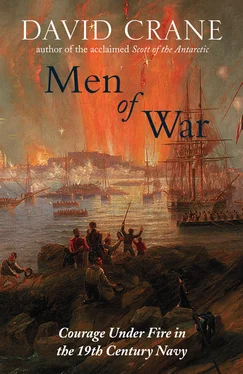Although it would be another two years, and endless disappointments, refinements and changes, before Hastings got his steamship, here in essence is the vessel that made his name. Over the past generation there had been various experiments on both sides of the Atlantic with the military application of steam, but if Hastings could not claim absolute priority – Frederick Marryat, Cochrane protégé and future novelist, commanding the sixty-horsepower Diana in the First Burma War of 1824–26 has that – such a vast gulf in terms of scale, ambition and power separates the vessel Hastings was proposing from Marryat’s that the age of steam in naval warfare only properly begins with him.
At a juncture in naval architecture at which the frigate was poised to reach its final, elegant apogee, in fact, there is something brutally modernist in Hastings’s utter disregard for the aesthetics of sail and line. The potential advantages of steam power – independence, predictability – were all the more vital among the capricious breezes of the Aegean, and what it gave Hastings above all was a delivery system that would enable him to bring to bear against an enemy the full weight of his gunnery as quickly and effectively as possible. ‘We now come to the plan of attack,’ he continued to Byron, conjuring up some steaming whirling dervish of a vessel:
In executing this, I should go directly for the vessel most detached from the enemy’s fleet, and when at the distance of one mile, open with red-hot shot from the 32-pounder forward. The gun laid at point blank, with a reduced charge, would carry on board en ricochetant . I would then wheel round and give the enemy one of the 68-pounders with shell laid at the line of metal, which would also ricochet on board him. Then the stern 32-pounder with hot shot, and again 68-pounder of the other side with a shell. By this time the bow-gun would be again loaded, and a succession of fire might be kept up as brisk as from a vessel having four guns on a side. Here the importance of steam is evident.
There would be, of course, a danger of the engine being hit, he conceded,
but when we consider the small object a low steamer would present coming head on, and the manner in which the Turks have hitherto used their guns at sea, this risk really appears very trifling. The surprise caused by seeing a vessel move in a calm, offering only a breadth of about eighteen feet, and opening fire with heavy guns at a considerable distance, may also be taken in to account. I am persuaded, from what I have seen, that in many cases the Turks would run their ships ashore and abandon them, perhaps without having the presence of mind to set fire to them.
For obvious reasons the use of red-hot shot at sea had always alarmed the men who sailed wooden vessels, but Hastings had seen too clearly for himself the effects it could have on ships not to believe there were technical solutions to the dangers. ‘Of the destructive effect of hot shot on an enemy’s ship,’ he told Byron,
it is scarcely necessary for me to speak. The destruction of the Spanish fleet before Gibraltar is well known. But if I may be permitted to relate an example which came under my proper observation, it will perhaps tend to corroborate others. At New Orleans the Americans had a ship and schooner in the Mississippi that flanked our lines. In the commencement we had no cannon. However, after a couple of days, two field-pieces of 4 or 6lb and a howitzer were erected in battery. In ten minutes the schooner was on fire, and her comrade, seeing the effect of the hot shot, cut her cable and escaped under favour of a light wind. If such was the result of light shot imperfectly heated – for we had no forge – what would be the effect of such a volume as a 32-pounder? A single shot would set a ship in flames.
The risks, too – introducing the red-hot shot before laying the guns, the problems associated with firing shells, the dangers of a shell rolling in a horizontal bore, the transport of shells around the ship – were all more apparent than real, but it seems unlikely that anyone with a boredom threshold as low as Byron’s was still reading. The central message, though, had sunk in. Finlay once remarked that there was not one but two Byrons at Missolonghi: the ‘feminine’ (as he curiously and revealingly put it) Byron who performed in company – vain, frivolous, mercurial; and the ‘masculine’ Byron, all intellect and good sense, who came out in one-to-one conversation. It was this second Byron – whatever lies to the contrary were later told – whose attention Hastings had caught. It makes it all the more of a shame that the two men never met, but Hastings’s letter would bear its posthumous fruit. As Byron moved from Cephalonia to Missolonghi and his own sacrificial death, harried and importuned on all sides, Hastings was about to discover the terrible irony of Byron’s Greek adventure: alive, there was little the First Genius of the Age could do; dead, nothing he could not. All that Hastings had to do was wait. And in the meantime, another and closer death had already brought his vision a step nearer.
VIII
It seems impossible to know now what contact he had had with Willesley in the eighteen months since he had sailed for Greece but Hastings’s departure had badly hurt his ageing father. For many years the old general had been living out his days with a more or less stoical patience, a spectator at a play that had long lost his interest, saddened by years of war, ill-health, the death of friends, the failing sight of his wife and disappointment in his sons. ‘Were it not for the sake of my children I know not whether I should have taken that trouble’ – of visiting Cheltenham for the waters – he had written as early as 1808, ‘after all – for what? To prolong the dream a few years longer – and which dream after all has not been a pleasant one – no, I think I should prefer confining myself to my convenient room, surrounded by my family, books and maps, and strive to spin out this dream at least contentedly if not comfortably – so much for sermonising.’
It would be hard, he conceded in 1813, ‘to quit the Theatre before the play is over and the curtain drops’, but with the defeat of Napoleon and the Kangaroo incident there was less and less to hold him. There is the occasional trace of him in the local newspaper – a bullock presented to the town for ‘a patriotic feast’ to celebrate Wellington’s Peninsula victories, the festivities to welcome the Marquis of Hastings back from India – but from the odd letter that survives, the only consolations of his old age seem to have been laudanum and the presence at Willesley of a little girl, a natural daughter of Sir John Moore adopted by the Hastings family after Corunna. ‘The young orphan who was a very bright, interesting and charming girl,’ Baron Louis le Jeune, a French prisoner of war at Ashby and – in the easygoing ways of a provincial town far from the sea – a dinner guest at Willesley, recalled, ‘was quite the life of the circle which her host and hostess gathered about them. The courtesy and kindness with which I was received did much to cheer my spirits, prisoner though I was.’
It is a poignant and elusive image – how she came, who her mother was, where she went, all seem mysteries – but whatever compensation the young Eliza Moore brought for the disgrace of Sir Charles’s ‘Trafalgar Hero’ it was tragically not enough. ‘My dear dear Mother,’ Frank’s older brother, Charles, wrote from Geneva on 9 October 1823, eighteen months after Frank’s departure for Greece:
This instant a courier has arrived with Mr McDonall’s letter, & the most melancholy intelligence it contains the sudden manner of its communication to me has thrown me into the greatest grief & sorrow – I am fearful to agitate your feelings my dear Mother by giving vent to my own, & I hardly know what I write or how to express myself … Keep yourself up my dearest Mother I beg of you … It is to me a great consolation that no one can have a moment’s doubt that my poor Father’s mind was quite gone …
Читать дальше











